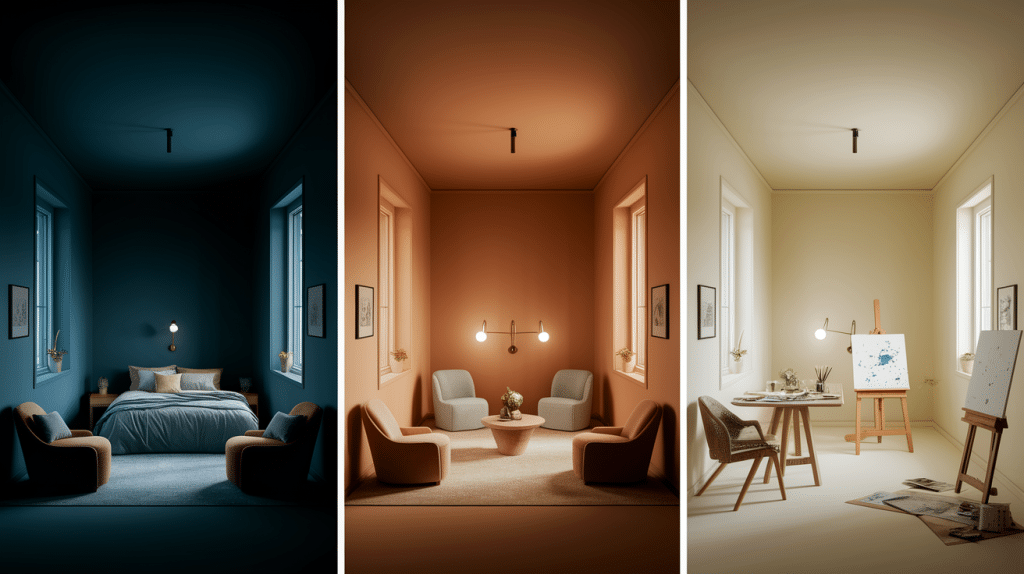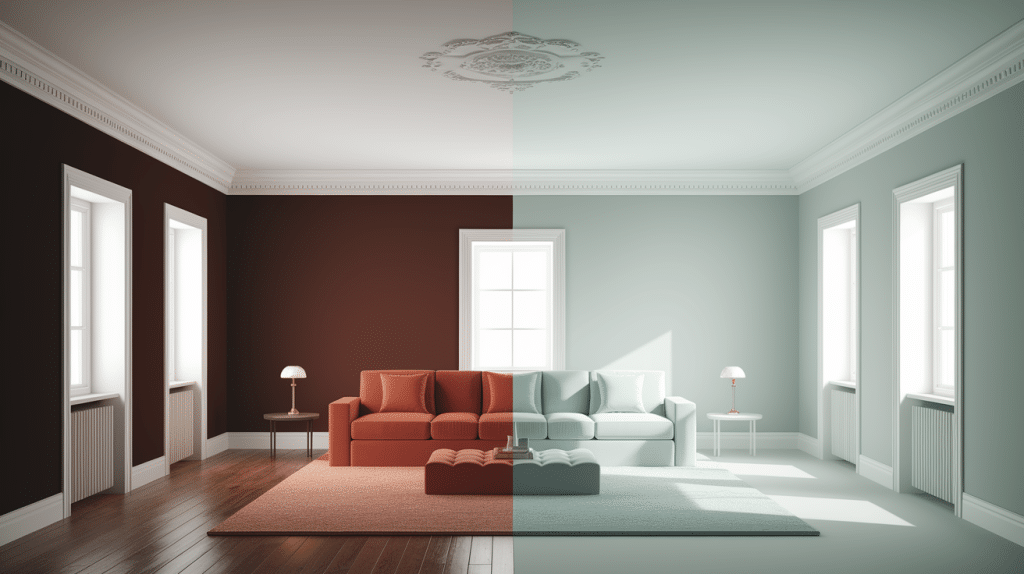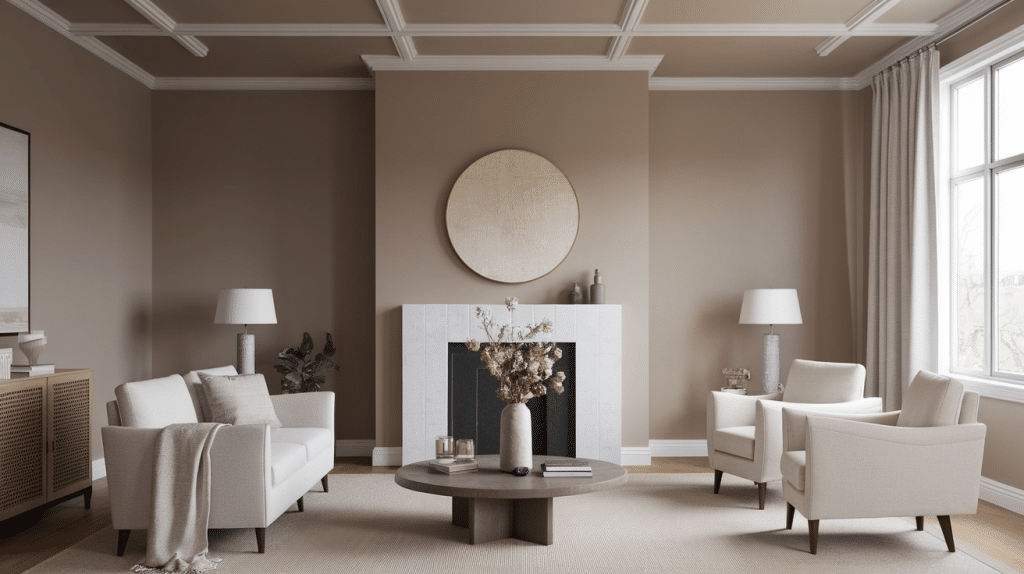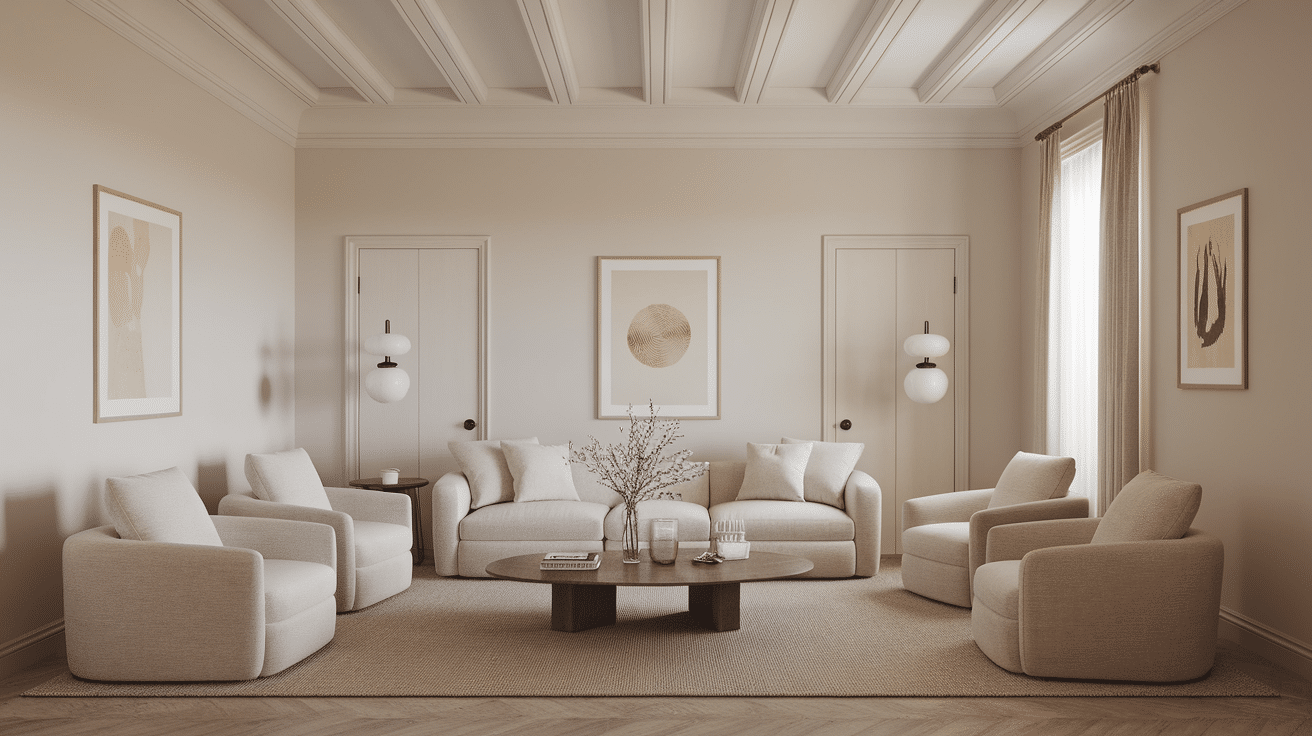Do white ceilings make you feel bored? For decades, most homes featured plain white ceilings while walls got all the color attention.
Times are changing. More homeowners now choose to paint their ceilings the same shade as their walls. This simple switch can completely change how a room feels.
But why should you try this method in your home? Matching your ceiling to your wall color can make small rooms feel bigger and low ceilings seem higher. It removes the harsh line that cuts across your vision and creates a more complete look.
This guide will show you when this technique works best, how to pick the right colors, and the exact steps to get a smooth finish.
Ready to learn how matching your ceiling and wall colors could be the perfect choice for your space?
1. Visual Unity: Creating Seamless Spaces
Painting your ceiling the same color as your walls removes harsh lines and creates a smooth flow. This works well in small rooms by making them feel larger. It also helps with odd-shaped spaces by hiding awkward angles and corners.
In rooms with low ceilings, this method can make the ceiling seem higher. The lack of contrast allows your eyes to move without stopping at the ceiling line.
Pro tip: Use matte or eggshell paint for both surfaces. These finishes add subtle depth while keeping the unified look.
2. Enhanced Mood and Atmosphere

Using the same color for both walls and ceiling changes how a room feels. This choice can strongly affect the mood of your space.
- Darker colors on all surfaces create a snug, comforting space. The walls and ceiling seem to wrap around you, perfect for rooms where you want to feel secure.
- Medium tones make rooms feel balanced and stable. They work well in spaces where you spend lots of time.
- Light colors on walls and ceiling create an open, fresh feeling. The room seems bigger and brighter.
This matching color method works perfectly in bedrooms where you want a calm, restful space. Reading nooks benefit from the cocoon-like feel of uniform color. Art studios and workspaces can use this trick to limit visual breaks that might pull focus from your tasks.
The color you select matters as much as the technique itself. Pick shades that support the room’s purpose and how you want to feel when you’re there.
3. Room Perception: Bigger, Taller, Better?

The White Ceiling Myth
The idea that white ceilings make rooms feel larger comes from old design rules. White does reflect more light, but it also creates a clear stopping point for your eyes. This visual break can make a room feel chopped up and smaller.
How Matching Colors Affect Room Size
When walls and ceiling share the same color, your eyes move smoothly around the space. Without the harsh line between surfaces, rooms often feel taller and wider. Dark colors pull walls inward while light colors push them outward. Both effects can work to your benefit when used correctly.
When to Use This Technique (And When Not To)
Go all-in with matching colors in:
- Rooms with odd angles or many corners
- Spaces with architectural flaws you want to hide
- Areas where you want a calm, unified feel
Skip this approach when:
- Your ceiling has beautiful details you want to highlight
- You have very tall ceilings you want to visually lower
- You want to create strong visual interest through contrast
The choice depends on what problem you’re trying to solve in your specific space.
4. Design Flexibility and Modern Appeal

Why Designers Choose This Look
Designers pick this method because it creates a solid background that works with many furniture styles.
The look feels fresh and thoughtful, moving away from the standard white ceiling that has been common for so long. It shows attention to detail and makes spaces feel carefully planned.
Creating a Canvas for Your Decor
When walls and ceiling share a color, your furniture and art get more attention. The room’s bones step back, letting other items stand out. This makes it easier to change small decor items without needing to repaint.
Your lamps, rugs, and artwork become the stars of the room.
Design Styles That Work Well
This painting method fits with several popular styles:
- Minimalist rooms with few items benefit from the calm, clean look
- Monochrome color schemes gain depth through this approach
- Modern farmhouse styles look more cohesive and less busy
- Mid-century modern spaces gain warmth and unity
The technique brings a subtle modern touch to any style while staying flexible enough to work with changing tastes over time.
Alternate Ideas
- Accent Ceilings: Paint your ceiling a bold, contrasting color to create a focal point. This works well in dining rooms or spaces with good lighting. A blue ceiling can feel like sky in sunrooms.
- Wallpaper Overhead: Add patterns to your ceiling with wallpaper. Subtle designs bring texture without weight. This works especially well in powder rooms or dining areas.
- Lighter Shade Variation: Use the same color as your walls but 20-30% lighter on the ceiling. This maintains unity while adding some height.
- Painted Borders: Keep your ceiling white but add a 12-inch border around the edges in your wall color. This frames the room nicely.
- Ceiling Stripes: Paint stripes on your ceiling to draw the eye and add interest. This can make a room look longer or wider depending on stripe direction.
Practical Tips for Painting Ceilings and Walls the Same Color
Painting your ceiling and walls the same color needs careful planning. Here’s how to get it right.
Choosing the Right Shade
Pick colors with careful attention to undertones. Colors look different on walls than on small samples. Paint tends to look darker on ceilings due to shadows. Test your color on both surfaces before buying all your paint.
Cool-toned colors make spaces feel larger and more open. Warm tones create cozy, welcoming rooms. Very dark colors need lots of natural light to work well.
Avoiding Visible Seams
Use high-quality paint for both surfaces. Buy all your paint at once to ensure color matching. Mix all cans together in a larger bucket for perfect color unity.
Paint the corner edges where walls meet the ceiling with a brush first. Then use a roller on larger areas. This “cutting in” method helps hide the seam between surfaces.
Tools and Techniques
| Tool | Purpose |
|---|---|
| Extension Pole | Helps reach ceiling areas without using a ladder |
| 2-Inch Angled Paintbrush | Ideal for cutting in around corners, edges, and trim |
| 3/8-Inch Nap Roller | Provides smooth coverage on walls without leaving texture |
| Painter’s Tape | Protects trim, baseboards, and other surfaces from accidental paint marks |
| Drop Cloths | Covers floors and furniture to prevent paint spills and splatters |
Apply paint in the same direction on both surfaces. Paint the ceiling first, then walls. Two thin coats look better than one thick one. Allow proper drying time between coats for the best results.
7 Common Mistakes to Avoid
1. Wrong Paint Finish – Using glossy paint on ceilings highlights every flaw; stick with matte or eggshell.
2. Ignoring Light Changes – Colors look different in morning versus evening light. Test in all lighting conditions.
3. Dark Colors in Small Spaces – Dark shades can make poorly lit rooms feel tiny and closed-in.
4. Skipping Primer – Primer helps paint stick evenly on both surfaces.
5. Rushing Between Coats – Not allowing proper drying time causes streaking and poor coverage.
6. Using Low-Quality Paint – Cheap paint requires more coats and shows more flaws on ceilings.
7. Painting Ceiling Last – Always paint the ceiling first to avoid splatter on finished walls.
Conclusion
When you paint your ceiling the same color as your walls, you can change how a room feels. This choice creates unity and a modern look that often makes spaces seem larger.
While white ceilings are common, matching colors brings a sense of completeness to the room. This method works well in oddly shaped rooms, simple designs, or when you want your furniture to be the main focus.
It’s not right for every space, but when used well, it fixes common visual issues and improves your home’s look. Whether you choose bold or soft colors, think about how you want people to feel when they enter.
Sometimes, a small change like matching your ceiling to your walls can create the biggest effect on your room’s overall feel.
Frequently Asked Questions
Is It Okay to Paint a Ceiling the Same Color as Walls?
Yes, it’s completely fine to paint your ceiling the same color as your walls. This can create a cohesive look and make a room feel larger.
What Is the Best Color to Paint a Ceiling?
White is the most popular ceiling color as it reflects light well. However, soft neutrals like pale blue, light gray, or cream also work wonderfully for ceilings.


